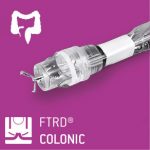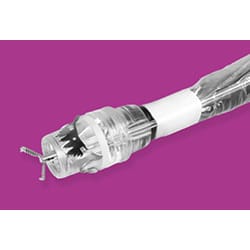FTRD® System | Largest meta-analysis on EFTR
Endoscopic Full-Thickness Resection: Meta-analysis of 26 studies confirms clinical benefit and considers FTRD® as primary alternative in non-lifting colonic lesions
A systematic review and meta-analysis evaluated the use of the FTRD System in 1565 procedures. The results revealed very high rates of technical success and R0 resection (pooled rate for reaching the target lesion: 96.1 %; pooled rate for technically successful resection: 90.0 %; pooled rate of histologically complete resection: 77.8 %). The risk of adverse events was low (pooled rate: 8.0 %).
The best studied device for EFTR is the FTRD System. Until recently, the current knowledge of the FTRD in the colon was mostly based on multiple smaller single-center studies. A. Wannhoff et al., Hospital Ludwigsburg, Ludwigsburg, Germany, conducted a systematic review and meta-analysis on EFTR in the colon aiming to assess the effectiveness and safety of the FTRD System in a large study setting.
In total, 26 studies (12 published as full-text, 14 conference abstracts) were analyzed on 8 outcome parameters (rate of target lesions that were reached with FTRD, rate of primary technical successful resection, rate of histological confirmed R0 resection, rate of difficulties during resection, rate of overall adverse events, rate of bleeding, rate of perforation and rate of need for emergency surgery due to an adverse event). Studies were included to the meta-analysis if they reported on at least one outcome parameter and at least 10 FTRD procedures in the colon.
The pooled rate for reaching the target lesion with FTRD was 96.1 % (95 % CI: 94.6–97.1, PI: 94.5–97.2). Primary technical successful resection of the target lesion was achieved with an estimate of 90.0 % (95 % CI: 87.0–92.3, PI: 76.5–96.1). The rate of histologically complete (R0) resection was 77.8 % (95 % CI: 74.7–80.6, PI: 68.3–85.0). Technical difficulties occurred in 6.1 % (95 % CI: 3.6–9.0; PI: 0.0–19.6), overall adverse events in 8.0 % (95 % CI: 5.8–10.4, PI: 1.9–16.7) of the cases. The pooled estimates for bleeding and perforation were 1.5 % (95 % CI: 0.3–3.3, PI: 0.0–10.6) and 0.3 % (95 % CI: 0.0–0.9, PI: 0.0–1.8), respectively. In most cases, adverse events could successfully be managed conservatively or endoscopically; the rate for need of emergency surgery after FTRD was 1.0 % (95 % CI: 0.4–1.8, PI: 0.4–1.9).
Wannhoff pointed out, that the large scale of this study did not affect the overall effectiveness calculated from previous studies, indicating a steep learning curve. Due to its highly feasible use, the system allows for endoscopic treatment of difficult adenomas. The authors concluded that the use of the FTRD System in the colon is efficient and safe and can be considered as the primary alternative to ESD or surgical resection in case of non-lifting lesions.
Systematic review and meta-analysis on effectiveness and safety of the full-thickness resection device (FTRD) in the colon.
Wannhoff A, Meier B, Caca K.
Z Gastroenterol. 2022 May;60(5):741-752.
ncbi.nlm.nih.gov/34587628/
 |
 |


 English
English  Deutsch
Deutsch 